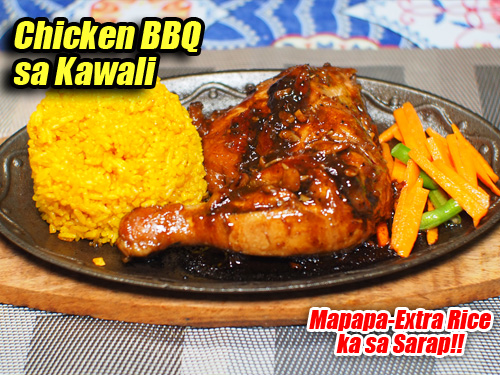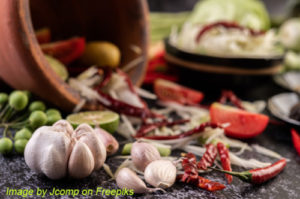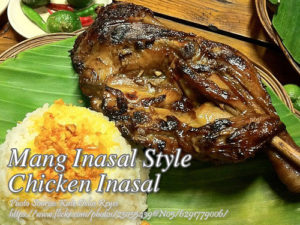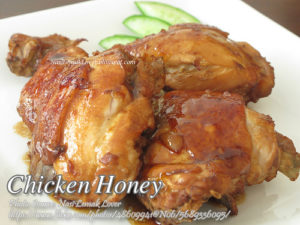Chicken barbecue sa kawali is a pan grilled version of the iconic sweet and savory Filipino chicken barbecue. The traditional way of cooking the chicken barbecue is using a charcoal grill to achieve the smoky and tasty sweet barbecue on a skewer. Cooking it the traditional way is tedious and most of the time if you are not skilled enough you will end up a burnt and almost black, dry and tough chicken barbecue. But using pan grill is easier and you will save yourself of irritating your eyes and nose of the smoke while cooking.
Chicken Barbecue sa Kawali: Made Easier on the Stovetop
When I was growing up in San Pablo, our backyard always smelled like Sunday lunch—smoky, sweet, and just a little bit charred. My Lolo Mario had this old metal grill propped up by bricks, and every weekend without fail, he’d be out there flipping skewers of chicken barbecue while fanning the coals with a banig. He swore that no other method could match the flavor of charcoal-grilled chicken. But you know what? Times have changed, and not all of us have the time, space, or even the patience to deal with live charcoal anymore.
That’s why I’m so grateful I learned this version of chicken barbecue sa kawali from my cousin Rhea when we visited her in Quezon City. She’s a single mom, works full-time, and still manages to cook amazing meals for her two kids. Her hack? Skip the grill and go straight to the stove. Same flavor, less hassle.
What Makes Chicken Barbecue sa Kawali So Special
Filipino-style chicken barbecue is known for its signature blend of sweet and savory. It’s marinated in a mix of soy sauce, calamansi, banana ketchup, sugar, and sometimes a splash of soda to tenderize the meat and give it that addictive glaze. Traditionally, it’s skewered and grilled over charcoal. The problem? It’s easy to burn. I’ve had my fair share of chicken that looked more like charcoal than meat, especially during family reunions when everyone’s too busy catching up to watch the grill.
With chicken barbecue sa kawali, you get that same bold flavor but cooked in a pan, no smoke in your eyes, no fire hazard, and definitely no blackened bits—unless you want them.
The Secret to Flavorful Pan-Grilled Chicken
When Rhea taught me her version, I asked her why she still bothered to marinate the chicken overnight. I mean, it’s going in a pan, right? She just laughed and said, “You think flavor happens in ten minutes?” Point taken.
Marinating overnight allows the chicken to absorb every bit of flavor from the garlic, soy sauce, calamansi, and sweet banana ketchup. The soda—usually Sprite or 7-Up—isn’t just for sweetness. The carbonation actually helps tenderize the meat, making it juicy and soft even after it’s cooked through.
Another tip: cutting slits into the chicken before marinating isn’t just for show. It helps the marinade seep deep into the meat and makes for quicker, more even cooking in the pan.
Why This Technique Works for Beginners
If you’ve ever been intimidated by the idea of grilling, this stovetop method is your new best friend. No skewering, no charcoal, no running outside with a tray of raw chicken while trying to swat away mosquitoes. Just heat your pan, sear the chicken until golden, then pour in the marinade and let the sauce do its magic.
As it simmers, the sauce thickens into a sticky glaze that clings beautifully to the chicken. The sugars caramelize, the soy sauce adds depth, and the banana ketchup gives it that unmistakably Pinoy sweetness. You’ll know it’s done when your kitchen smells like a street food stall in Cubao—rich, sweet, and absolutely mouthwatering.
A Little History Behind Filipino Barbecue
Barbecue culture in the Philippines is more than just food—it’s a tradition. Whether it’s a fiesta, a barangay sports tournament, or just inuman night, there’s always someone manning the grill. The flavors we use—like banana ketchup and calamansi—reflect our resourcefulness. Banana ketchup, for example, was developed during World War II when tomatoes were scarce. That twist gave our barbecue a unique personality you won’t find anywhere else.
With chicken barbecue sa kawali, we’re honoring that tradition while adapting it to modern Filipino kitchens. It’s the same heart and soul, just without the smoke.
How to Serve Chicken Barbecue Without the Grill
Once your chicken is perfectly glazed and tender, serve it hot with a side of java rice and buttered vegetables, just like they do in those old-school Filipino diners. If you have a sizzling plate, even better—your table will feel like a turo-turo spot in Makati.
And here’s a pro tip from my Kuya Edong, who used to work in a carinderia back in the day: spoon a bit of that reduced sauce over your rice. Don’t let any of it go to waste—it’s liquid gold.
Chicken barbecue sa kawali might not have the smokiness of the traditional version, but it makes up for it in ease, consistency, and bold Filipino flavor. Whether you’re a beginner cook or just looking for a quick way to enjoy a classic dish, this one’s a winner.
Let me know if you want to try this with pork next—my Ate Lina has a killer version she swears tastes better than any street food. But that’s a story for another day.
How to Cook Chicken Barbecue sa Kawali
Ingredients
- 1 kilo chicken leg quarter
- 1 cup sprite or 7-up softdrinks
- 6 cloves garlic
- 1 Tbsp. ketchup
- 2 Tbsp. sugar
- 1 tsp. black pepper
- 1 Tbsp. oyster sauce
Instructions
How to Cook Chicken Barbecue sa Kawali
- Trim the excess fat then wash in running water. Put in a colander to drain excess water.
- Cut slits on the chicken then put in a mixing bowl.
- Add garlic, black pepper, calamansi juice, sugar, soy sauce, oyster sauce, banana ketchup and 7 Up or sprite softdrinks. Mix the ingredients and marinate overnight.
- Heat pan grill or frying pan then put chicken do not include the marinade yet.
- Cook the chicken for a few minutes until slightly brown on all sides. Then add the marinade.
- Cover and cook for ten minutes. Uncover and let it cook until the sauce is reduced. Turn the chicken while cooking until the sauce is very thick.
- Remove from pan and serve hot. You can also put it in a sizzling plate with java rice and buttered vegetables.
Video
Notes
Cooking Tips:
Marinate Overnight for Maximum Flavor
Don’t rush the marinade—letting the chicken sit overnight gives it time to fully absorb the sweet, tangy, and savory flavors. The acids from the calamansi and soda tenderize the meat while the soy sauce and banana ketchup build a deep, rich taste. The longer it soaks, the more flavorful each bite will be.Use Medium Heat to Avoid Burning
Cooking on medium heat helps caramelize the sugars in the marinade without burning the outside too quickly. High heat can char the skin before the chicken is fully cooked inside. Let the sauce slowly reduce so it thickens into a glaze instead of drying out.Let the Sauce Thicken Before Serving
Once you add the marinade back into the pan, resist the urge to rush the process. Let it simmer until the sauce becomes sticky and coats the chicken evenly. This final step locks in flavor and gives that beautiful, glossy barbecue finish.





Leave a Reply